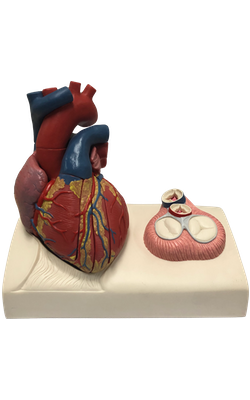Main Model

Tricuspid valve

The tricuspid valve guards the right atrioventricular orifice. The bases of the valve cusps are attached to the fibrous ring around the orifice. Because the fibrous ring maintains the caliber of the orifice, the attached valve cusps contact each other in the same way with each heartbeat. Tendinous cords (Latin chordae tendineae) attach to the free edges and ventricular surfaces of the anterior, posterior and septal cusps, much like the cords attaching to a parachute. The tendinous cords arise from the apices of papillary muscles, which are conical muscular projections with bases attached to the ventricular wall. The papillary muscles begin to contract before contraction of the right ventricle, tightening the tendinous cords and drawing the cusps together. Because the cords are attached to adjacent sides of two cusps, they prevent separation of the cusps and their inversion when tension is applied to the tendinous cords and maintained throughout ventricular contraction (systole) - that is, the cusps of the tricuspid valve are prevented from prolapsing (being driven into the right atrium) as ventricular pressure rises. Thus, regurgitation of blood (backward flow of blood) from the right ventricle back into the right atrium is blocked during ventricular systole by the valve cusps.
Three papillary muscles in the right ventricle correspond to the cusps of the tricuspid valve:
1. The anterior papillary muscle, the largest and most prominent of the three, arises from the anterior wall of the right ventricle; its tendinous cords attach to the anterior and posterior cusps of the tricuspid valve.
2. The posterior papillary muscle, smaller than the anterior muscle, may consist of several parts; it arises from the inferior wall of the right ventricle, and its tendinous cords attach to the posterior and septal cusps of the tricuspid valve.
3. The septal papillary muscle arises from the interventricular septum, and its tendinous cords attach to the anterior and septal cusps of the tricuspid valve.